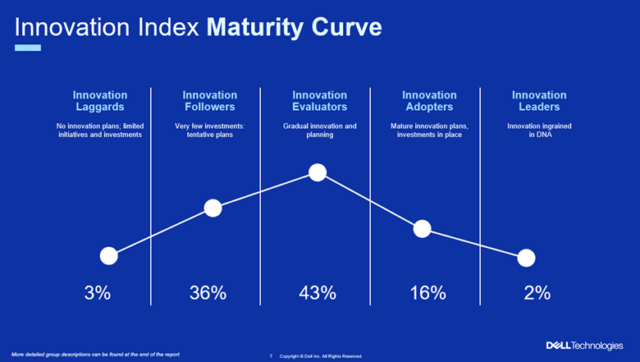By Sara Downey and Janine Wegner, Thought Leadership, Dell Technologies
There’s a powerful equation in business: an innovative idea plus technology equals impact. But what makes innovation possible? How do you measure its success? And how can you continue to innovate throughout turbulent times?
These were key questions that we wanted to explore at the onset of the Innovation Index, a new study by Dell Technologies. The study polled 6,600 respondents across 45-plus countries who are charged with shaping or influencing innovation in their organizations. IT and business decision-makers from multiple industries were asked to gauge their organizations’ innovation resilience and how they might fare through periods of volatility to deliver results when the business needs to most.
A holistic framework for intentional innovation
Prior to the study, we spoke to various organizational leaders who unanimously agreed that under the right conditions, innovation can spring from big, bold ideas, as well as small, pragmatic ones, to create a ripple effect that leads to greater productivity, profitability and purpose. But it begins with the holistic framework of a strategy built around an organization’s people, processes and technologies.
This message comes through loud and clear in the study findings that businesses are losing talent by not empowering people to innovate— nearly 6 in 10 respondents believe people leave their company because they haven’t been able to innovate as much as they hoped they would. And 57% worry that, based on their innovation culture/pipeline, their organization won’t be relevant in the next three to five years. These insights are the bedrock of the Innovation Index, a far-ranging study that illustrates why innovation culture should be the beating heart of an organization.
Measuring readiness to innovate

The size of the task ahead is powerfully illustrated by the Innovation Index maturity curve. By benchmarking respondents’ organizations based on how well they’re driving innovation in their organization and placing them on a spectrum, we can see that just 18% of organizations worldwide have been categorized as Innovation Leaders and Adopters. The bulk of organizations are either stuck in the evaluation phase or lack an innovation strategy.
The Innovation Index benchmark is also a useful teaching tool. By stratifying respondents, we can see where challenges lie and what it takes to increase innovation maturity. Organizations that might have come to a dead end with their innovation can take cues from Innovation Leaders and Adopters, who are excelling.
For instance, they can discover that Innovation Leaders and Adopters are 2.2x more likely to accelerate their innovation during a recession than Innovation Followers and Laggards (who are more likely to decelerate). By powering through, they’re securing the competitive advantage.
The Innovation Index as a tool for assessment
The study points the way to more impactful innovation and, ultimately, business resilience and profitability (it’s no coincidence that Innovation Leaders and Adopters are 1.9x more likely to experience higher levels of revenue growth than Innovation Laggards and Followers). It demonstrates that organizations see innovation as a business imperative and are doing the following:
- Building an innovation culture where any idea can make a difference and learning through failure is encouraged.
- Embedding a structured, data-driven innovation process to capture and realize innovation across the organization.
- Resolving complexity (arguably the greatest stumbling block to innovation) by investing in modern, scalable technologies and strengthening the business and IT relationship to increase technology and innovation maturity.
In short, the Innovation Index reminds us that innovation isn’t a side project; it is the essence of the organization. It can be born from game-changing, disruptive ideas, or it can be the cumulative effect of incremental improvements that benefit each end-user. Either way, it’s vital. Now is the moment for organizations to assess how their people, processes and technologies are abetting innovation in turbulent times. Learning from leading innovators on how to navigate the challenges of today can provide a much-needed roadmap to innovation resilience that can be followed for years to come.
To learn more about the study, click here, and look to Perspectives throughout the year for updated articles with advice from experts on how to accelerate from ideas to innovation.

